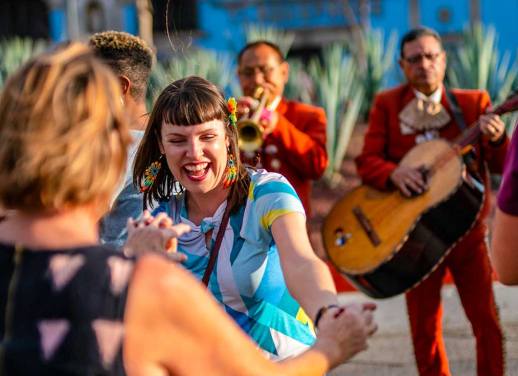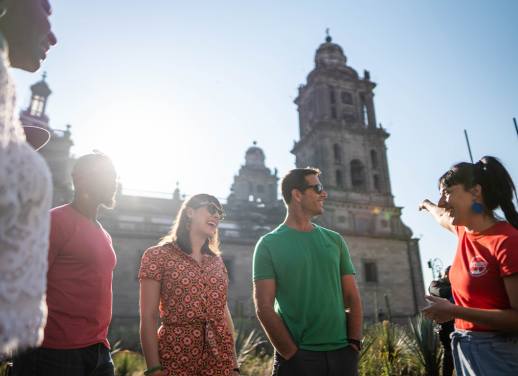For solo traveller and writer Gemma, a half-day, hands-on cooking tour of Mexico City’s Centro Historico and Jamacia neighbourhoods was the added flavour she needed for a memorable adventure.
I make a promise to myself as I landed in Mexico City: to eat as many tacos as possible during my short four-day adventure.
Safe to say, I well and truly deliver on that in the first two days, gorging the servings at Jenni’s Street Quesadilla – a small corner stall in Roma Norte – in between time spent searching for textiles and artworks at Coyoacan Market, drinking in the backstreet bars along Calle Colima and admiring the collections at the National Museum of Anthropology. But something is still missing.
I’m having the time of my life, but with limited Spanish and not feeling super confident exploring beyond the comforts of Roma Norte’s trendy bars and Condesa’s European-style boutique hotels, I feel a little disconnected from the city’s authentic culture and stories. I fear I’ve taken on the advice from friends and family back home too literally: ‘Stay within Roma Norte and you’ll be safe’.
However, that changes in just a few hours on my half-day Urban Adventures tour of Mexico City’s markets and secret salsa-making spots. Within moments of meeting our local leader, Adriana – artfully adorned in colourful bracelets, earrings and trendy piercings – she explains that by lunchtime we’ll get the chance to contribute to over 100 years of history, storytelling and flavour, thanks to a hands-on salsa-making workshop, using a volcanic stone bowl, known as a molcajete, that’s been passed down through five generations.
Immediately, I’m excited. ‘To understand the culture of Mexico,’ Adriana smiles, ‘you have to first understand the markets.’
That’s when I know this isn’t going to be a regular food tour. The table is set for a masterclass in connection: to Mexico City’s people, flavours and stories.



Market tales and tamales
We start early at 8:30 am outside the Metropolitan Cathedral in the Centro Historico and reach our first stop, the Mercado Abelardo l Rodriguez, after a short 15-minute walk, just as the market lights are flickering on and the vendors begin arranging their stalls.
Adriana mentions this market isn’t on most travellers’ itineraries, due to its traditional stalls selling vegetables, grains and household items.
As we reach an unassuming corner spot on the edge of the market, I notice big metal pots selling atole – a milky, thickened drink, flavoured with cinnamon – which, of course, we have to try.
The city is just beginning to come to life around us: motorbikes buzz past, horns blare, vendors call out in Spanish. It’s a treat to enjoy a relaxed moment together among the rising city excitement, as we sip our thick, porridge-like drinks and share tamales – the traditional Mesoamerican corn-dough dish, steamed in banana leaves and filled with cheese, pork or chicken.
After so many solo meals, it feels meaningful to sit and taste the different tamales while listening to Adriana tell us about the history of corn and the mostly vegetarian diet of the Aztec. Almost as if we’re gaining a more nuanced view of the city with every single bite.
After we eat, we climb a narrow set of stairs inside the market to find a collection of murals from the 1930s, painted by students of Diego Rivera. Adriana pauses under one showing all the workers of the market, to highlight where the produce comes from – and the power of the people.
‘These murals aren’t just decoration,’ she says. ‘They tell the story of Mexico’s history.’ Back in the 1930s, the building was imagined as a new type of market – one that even included a theatre and a library. Right to this day, nearly a century later, the open spaces and stages at the top of the staircase are still used for lessons, dancing and community events, she explains.



From train hopping to market hopping
Next up, is a quick ride on the city’s subway in the women’s carriage. With 12 lines and 195 stations, it’s the second-largest transit system in North America, and exactly the sort of thing I might have avoided by myself, had I stayed within Roma Norte and Condesa. In this moment, it feels like a small win.
Exiting at Jamaica metro station, we reach our second market, Mercado de Jamaica in the Jamacia condesa, home to colourful, fragrant food stalls, and vendors selling opulent Day of the Dead flowers (used in the city’s Día de los Muertos celebrations) – as well as ebullient floral arrangements for funerals, celebrations or no reason at all.
‘People love to buy flowers for their loved ones,’ says Adriana. ‘We’re romantics in Mexico City’.
We sample mole first – a deep, smoky sauce, layered with chocolate, chilli and spices – as Adriana explains that each paste has its own story: different nuts, different seeds, different hands blending them.
Then, weaving past rows of pinatas, we move on to sample grilled corn dusted in chilli salt and butter, slices of mango with lime and sugar-dusted pastries known as pan dulce (sweet breads). Each bite feels like a piece of the city’s recipe revealing itself.



Salsa and century-old stories
We make our way over the road just outside Mercado de Jamaica to a cluster of open-air restaurants and food stalls, to enter a family-run kitchen hosted by Dona Esther – or ‘Tete’, as she likes to be called – dressed in a crisp white apron, hair pulled back into a bun, warm eyes welcoming all into her space.
We’re greeted by the scent of charred chillies, fresh herbs and music filling the open-air stalls. Tete’s family has been working as street vendors since 1937 and in this market stall since 1957. It’s since been passed down from generation to generation – along with her prized molcajete.
Adriana explains that every salsa (the traditional sauce used as condiments for tacos and other Mexican dishes) made in the volcanic bowl, leaves a trace behind: layers of flavour and fragments of memory carved into the stone. She hands me the pestle.
‘Your turn,’ she grins. ‘Let’s see how you go.’
First, I start by grilling tomatillos (small, slightly sour and tangy, Mexican husk tomatoes) and native palm-length green chillies, before grinding them by hand into a traditional salsa, using the century-old bowl. I’m hoping for a smile of approval for my (admittedly pretty average) chopping and grinding skills. So, needless to say, I’m secretly thrilled when Adriana jokingly says I pass the test.



A flavour that feels authentic
What stays with me most from my tour of Mexico City’s markets isn’t just the taste of the spicy salsa, packed with layers of charred vegetables and aromatics, served with toasted cactus on a corn flatbread (although, it’s unforgettable). It’s the community spirit between the restaurant vendors: families and friends drifting in and out of each other’s stalls, swapping ingredients, lending hands, sharing laughs and serving piping hot food right before the hungry guests.
Adriana says it always feels like home when she takes travellers to this spot – and tells me she’s known the family for many years. For the first time, I feel like I’m not just observing the city: I’m in it, part of the fun.
‘Supermarkets will never replace the market experience,’ Adriana says, shaking her head. I couldn’t agree more.
In just a few hours, I’ve found the missing ingredient I’d been searching for. Turns out, the best of Mexico City isn’t in the hipster shops and restaurants of Roma Norte or even the museums, but in a tucked-away, open-air kitchen in a neighbourhood I didn’t have on my radar, in a shared bowl of salsa and in the joy of discovering how food connects us all.
Add extra flavour to your city break with Urban Adventures and the five-hour Mexico City Market Secrets & Salsa-Making Lesson experience.




